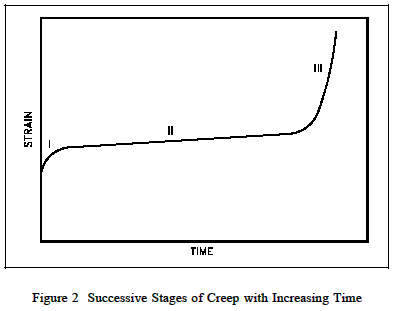|
At room temperature, structural
materials develop the full strain they will exhibit as soon as a load is
applied. This is not necessarily the case at high temperatures (for example,
stainless steel above 1000�F or zircaloy above 500�F).
At elevated temperatures and constant stress or load, many materials continue to
deform at a slow rate. This behavior is called creep. At a constant stress and
temperature, the rate of creep is approximately constant for a long period of
time. After this period of time and after a certain amount of deformation, the
rate of creep increases, and fracture soon follows. This is illustrated in
Figure 2.
Initially, primary or transient
creep occurs in Stage I. The creep rate, (the slope of the curve) is high at
first, but it soon decreases. This is followed by secondary (or steady-state)
creep in Stage II, when the creep rate is small and the strain increases very
slowly with time. Eventually, in Stage III (tertiary or accelerating creep), the
creep rate increases more rapidly and the strain may become so large that it
results in failure.

The rate of creep is highly
dependent on both stress and temperature. With most of the engineering alloys
used in construction at room temperature or lower, creep strain is so small at
working loads that it can safely be ignored. It does not become significant
until the stress intensity is approaching the fracture failure strength.
However, as temperature rises creep becomes progressively more important and
eventually supersedes fatigue as the likely criterion for failure. The
temperature at which creep becomes important will vary with the material.
For safe operation, the total
deformation due to creep must be well below the strain at which failure occurs.
This can be done by staying well below the creep limit, which is defined as the
stress to which a material can be subjected without the creep exceeding a
specified amount after a given time at the operating temperature (for example, a
creep rate of 0.01 in 100,000 hours at operating temperature).
|